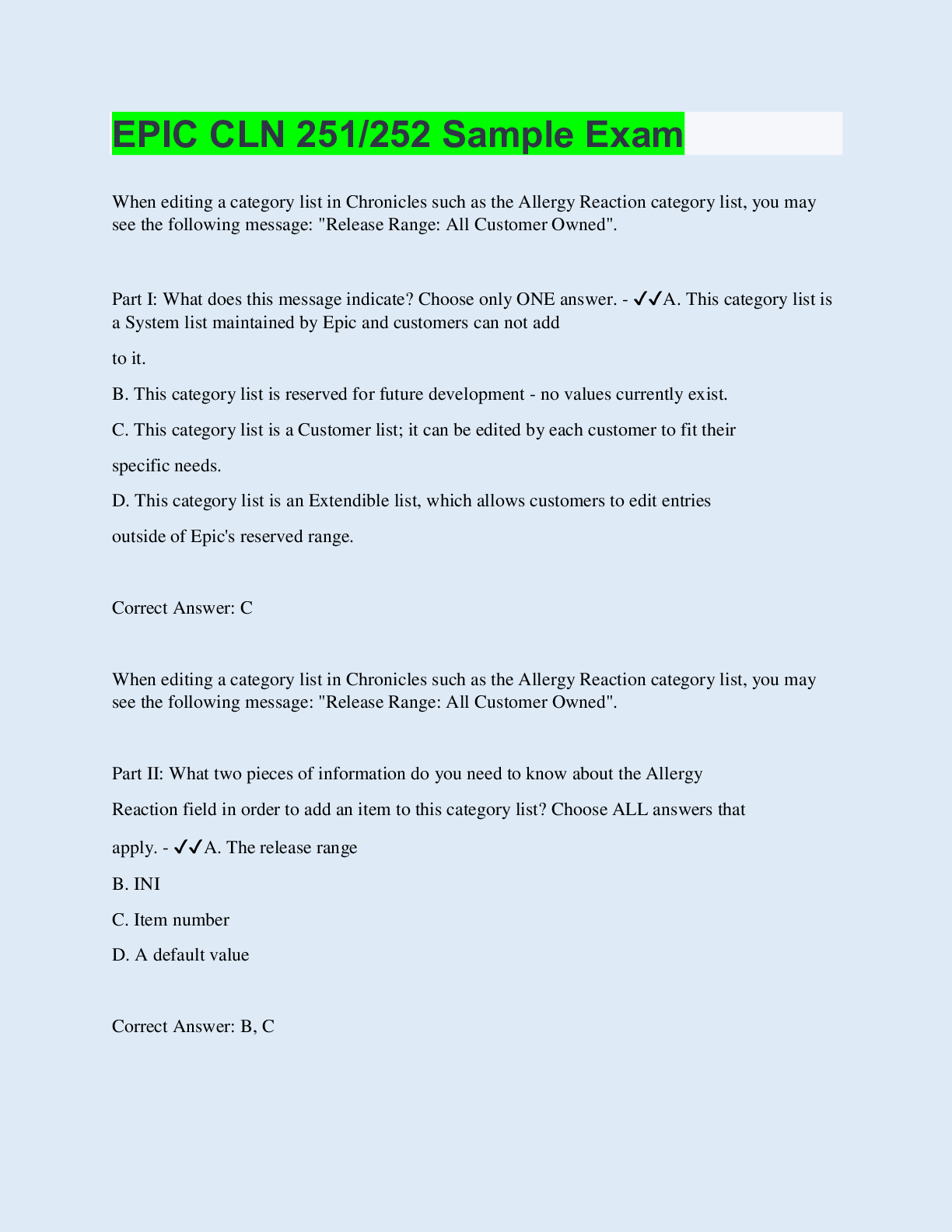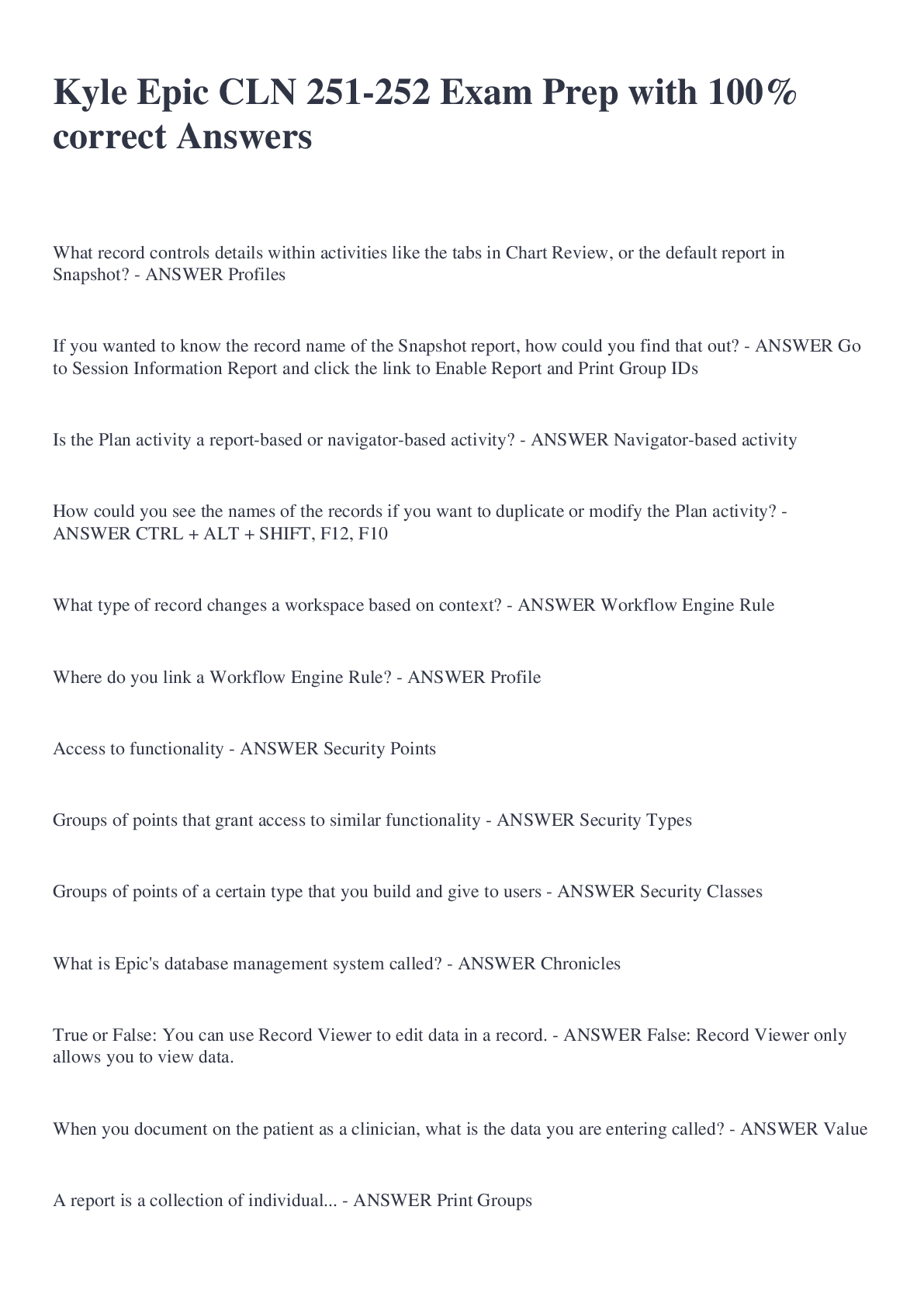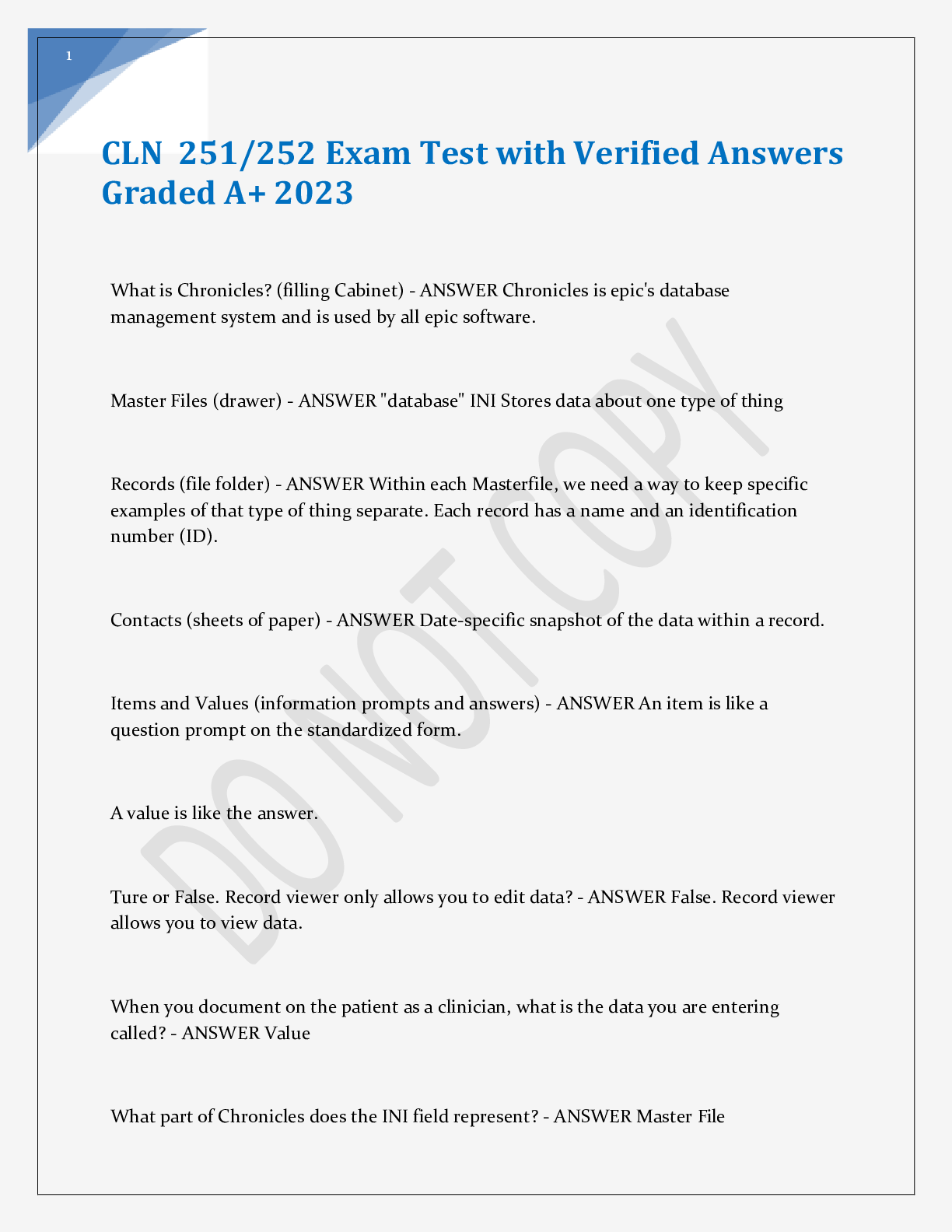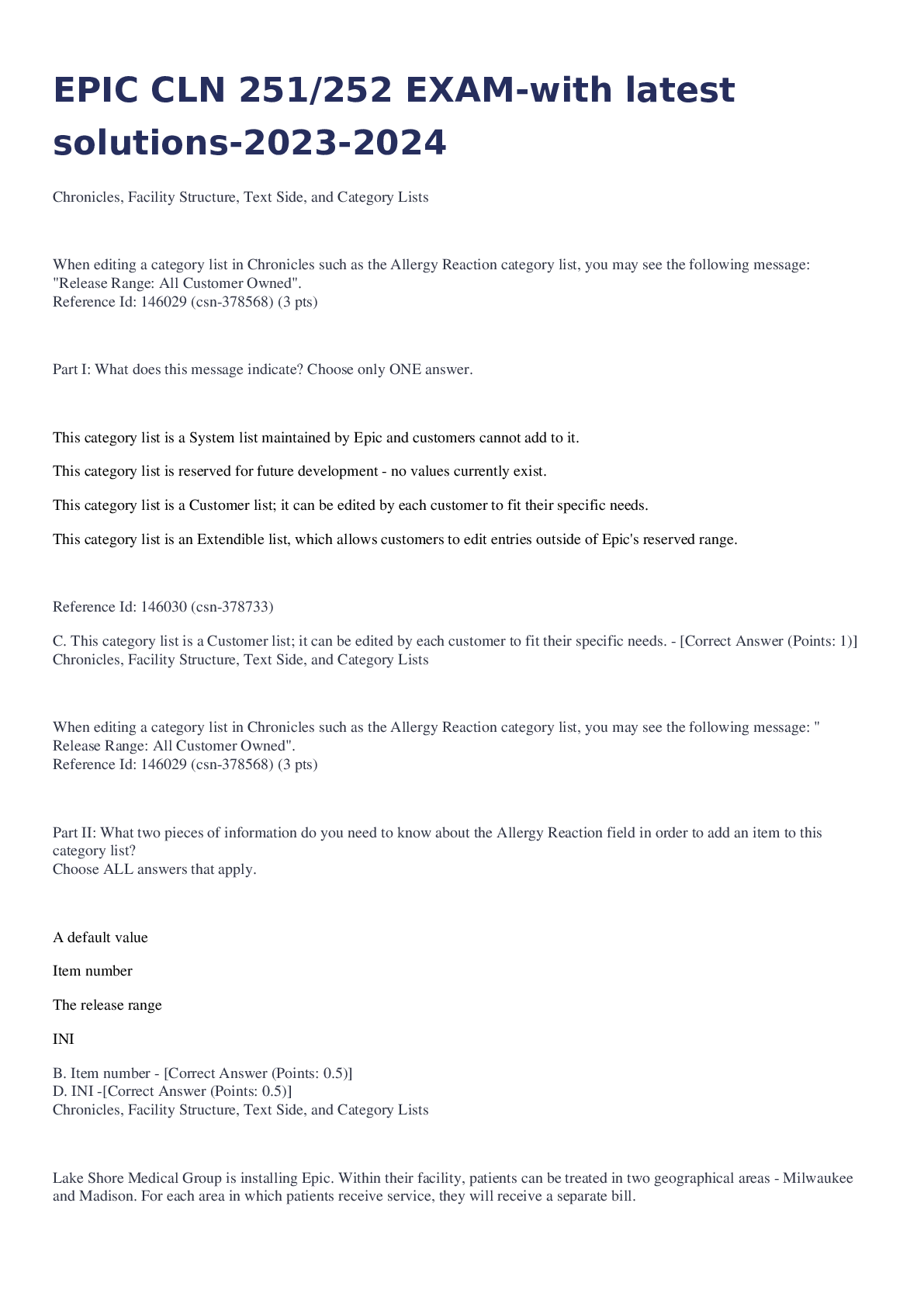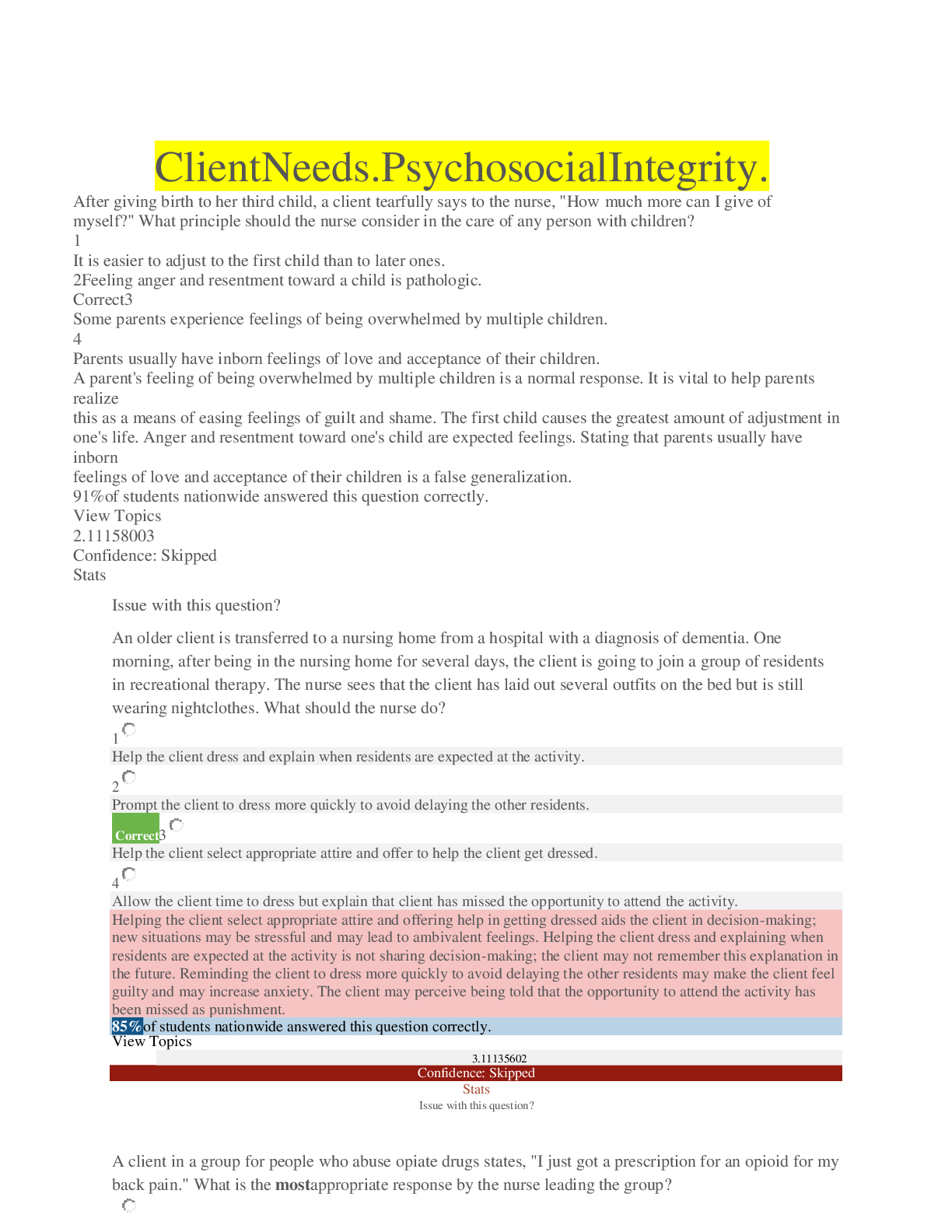GNRS MISC OB Lab and birth experience quiz 1 Latest updated,100% CORRECT
Document Content and Description Below
1: A nurse notices that a client in the first stage of labor seems agitated. When the nurse asks why she's upset, she begins to cry and says, "I guess I'm a little worried. The last time I g... ave birth, I was in labor for 32 hours." Based on this information, the nurse should include which nursing diagnosis in the client's care plan? You selected: Fear related to a potentially difficult childbirth Correct Explanation: A client's ability to cope during labor and childbirth may be hampered by fear of a painful or difficult childbirth, fear of loss of control or self-esteem during childbirth, or fear of fetal death. A previous negative experience may increase these fears. Therefore, fear related to a potentially difficult childbirth is the most appropriate nursing diagnosis. The client's anxiety stems from her past history of a long labor, not from being in the facility; therefore a diagnosis of anxiety related to the facility environment isn't warranted. There is no evidence of compromised family coping related to hospitalization. Although acute pain related to labor contractions may be a problem, the information provided by the client doesn't support this diagnosis. Question 2: (see full question) What would be the priority when caring for a primigravid client whose cervix is dilated at 8 cm when the fetus is at 1+ station and the client has had no analgesia or anesthesia? You selected: offering encouragement and support Correct Explanation: The client is in the transition phase of the first stage of labor. During this phase, the client needs encouragement and support because this is a difficult and painful time, when contractions are especially strong. Usually, the client finds it difficult to maintain self-control. Everything else seems secondary to her as she progresses into the second stage of labor. Although ice chips may be given, typically the client does not desire sips of water. Labor is hard work. Generally, the client is perspiring and does not desire additional warmth. Frequent perineal cleansing is not necessary unless there is excessive amniotic fluid leaking. (less) Question 3: (see full question) A primary care provider has prescribed nalbuphine hydrochloride 10 mg intravenously for a client in active labor. The pharmacy supplies a vial labeled as 50 mg in a 5-mL vial. How many milliliters should the nurse administer? Record your answer using a whole number. You selected: 1 Correct Explanation: The nurse should administer 1 mL of the solution, calculated as follows: 50 mg/5 mL = 10 mg/x. 50 x = 50 mL. x = 1 mL. Question 4: (see full question) A nurse needs to obtain a good monitor tracing on a client in labor The client lies in a supine position. Suddenly, she complains of feeling light-headed and becomes diaphoretic. Which action should the nurse perform first? You selected: Reposition the client to her left side. Correct Explanation: This client is hypotensive because of decreased blood flow through the aorta. By turning the client to her left side, the nurse removes the weight of the uterus from the aorta and increases the maternal blood flow. Taking blood pressure, summoning the physician, starting oxygen, and increasing I.V. fluids aren't necessary unless repositioning doesn't relieve the symptoms. (less) Question 5: (see full question) The nurse is explaining to a primagravida in labor that her baby is in a breech presentation, with the baby’s presenting part in a left, sacrum, posterior (LSP) position. Which illustration should the nurse use to help the client understand how her baby is positioned? You selected: Correct Explanation: This figure shows the client’s baby in a breech presentation with the baby facing the pelvis on the left, the sacrum as the presenting part, and the presenting part (sacrum) is posterior in the pelvis. Figure 2 shows a vertex presentation with the baby in a left, occiput, anterior position (LOA). Figure 3 shows a vertex presentation, left, occipit, posterior (LOP). Figure 4 shows a face position with the baby in a left, mentum, transverse position (LMT). (less) Question 6: (see full question) A 31-year-old client, G3, T0, P2, Ab0, L0 at 32 weeks’ gestation, is being admitted to the hospital with contractions of moderate intensity occurring every 3 to 4 minutes per the client report. The client is crying on admission; the history reveals that the client has previously had two nonviable fetuses at 30 weeks’ gestation. What nursing action would be the highest priority for this client? You selected: Assess maternal contraction and fetal heart rate pattern. Correct Explanation: The physical aspects of care have a higher priority than the psychosocial aspects. The client report is part of the electronic medical record, but the maternal contraction pattern and the fetal heart rate pattern must be completed immediately upon admission to establish a baseline. The need for a tocolytic agent cannot be determined until the maternal fetal unit has been assessed. Assessment of the circumstances and etiologies of the prior fetal demises are important but are not of the highest importance. The psychosocial aspects are very important in the care of this client and can briefly be discussed as the physical aspects of assessment are being completed, but in-depth psychosocial care will need to wait until the physical aspects have been completed. (less) Question 7: (see full question) A pregnant client’s partner coaches her with breathing and relaxation techniques as they were taught in childbirth preparation classes. When the client reaches the transition phase of labor, she screams out, “I cannot do this anymore!” Which suggestion would be most helpful for the client’s partner? You selected: “Maintain direct eye contact and breathe with her." Correct Explanation: The transition stage of labor requires reinforcement of techniques learned during preparation for childbirth classes. It is best to use direct eye contact and breathe with the client when she loses control during the transition stage. This often helps her regain control. The client should be encouraged to focus on one contraction at a time at this point in labor. Telling the partner that the nurse to take over the coaching is not appropriate. It diminishes his role and may instill feelings of failure. When the client reaches transition, or 8 to 10 cm of dilation, it is usually too late for anesthesia. The client will soon need to expel the fetus. Anesthesia at this point may cause respiratory depression in the neonate. Telling the partner to let the client know that it will soon be over does not help her gain control. This type of response is placating and is not helpful for the client. (less) Question 8: (see full question) Two clients arrive at the labor and delivery triage area at the same time. The first client states that her water has been leaking, but that she hasn't had any contractions. The second client says she's having 1-minute contractions every 3 minutes and that she feels like pushing. How should a nurse prioritize these clients? You selected: The nurse should assign priority to the second client. Her signs and symptoms indicate that her baby's birth is imminent. Correct Explanation: Regular contractions 3 minutes apart and 1 minute in duration along with an urge to push, as exhibited in the second client, indicate a pending delivery. Priority should be assigned to this client. Leaking amniotic fluid that appears to be clear, as exhibited in the first client, doesn't indicate that contractions are about to begin. This client is less of a priority. (less) Question 9: (see full question) External monitoring of contractions and fetal heart rate of a multigravida in labor reveals a variable deceleration pattern on the fetal heart rate. What should the nurse do first? You selected: Change the client's position. Correct Explanation: Variable decelerations, common after membranes rupture, usually indicate cord compression. Repositioning the client often helps to correct this fetal heart rate pattern. If repositioning is not successful, the clinician may choose to perform amnioinfusion of sterile saline solution into the uterus through a sterile catheter to help take the pressure off the cord. The nurse may wish to alert the obstetrician or nurse midwife, but the anesthesiologist is responsible for anesthesia, not for the fetus. Administering oxygen at 2 L is not helpful because pressure on the cord must be relieved first. Changing the client’s position and administering oxygen often resolve the cord compression. There is no need to prepare the client for a cesarean birth at this time. A cesarean birth would be indicated for prolonged fetal distress. (less) Question 10: (see full question) For a primigravid client with the fetal presenting part at ?1 station, what would be the nurse’s priority immediately after a spontaneous rupture of the membranes? You selected: Check the fetal heart rate. Correct Explanation: Immediately after a spontaneous rupture of the membranes, the nurse should listen to the fetal heart rate to detect bradycardia. With the fetus at ?1 station, the cord may prolapse as amniotic fluid rushes out. Fetal heart rate should be monitored because it will indicate if cord prolapse or cord compression has occurred. The color, amount, and odor of the amniotic fluid should be noted. Although the optimal position for the client is side lying, this is not a priority at this time. The client is not having a precipitous birth with the fetal head at ? 1 station. Therefore, preparing the client for a cesarean birth is unnecessary. Although maternal blood pressure should be monitored throughout labor, this is not a priority at this time. (less) Question 11: (see full question) A client in the first stage of labor is being monitored using an external fetal monitor. After the nurse reviews the monitoring strip from the client’s chart, into which of the following positions would the nurse assist the client? You selected: Left lateral Correct Explanation: The fetal heart rate monitoring strip shows late decelerations, which indicate uteroplacental circulatory insufficiency and can lead to fetal hypoxia and acidosis if the underlying cause is not corrected. The client would be turned onto her left side to increase placental perfusion and decrease contraction frequency. In addition, the intravenous fluid rate may be increased and oxygen administered. The right lateral, supine, and prone positions do not increase placental perfusion. (less) Question 12: (see full question) A multigravida with a history of cesarean birth due to fetal distress is admitted for a trial labor and possible vaginal birth. After several hours of active labor, the primary care provider prescribes nalbuphine. The nurse evaluates the drug as effective when the client makes which statement? You selected: "The contractions do not seem as painful as before.” Correct Explanation: Nalbuphine, a synthetic agonist-antagonist similar to butorphanol and pentazocine, is used for analgesia during labor. Thus, the statement about the contractions seeming less painful indicates that the drug is effective. The client should not experience numbness or anesthesia from this drug. Although the client may rest or fall asleep after administration, the drug is not a sedative. Cimetidine, not nalbuphine, is given to counteract indigestion (heartburn). The drug is not given to counteract nausea. However, nausea and dry mouth are potential adverse effects of nalbuphine. (less) Question 13: (see full question) When assessing the fetal heart rate tracing, a nurse becomes concerned about the fetal heart rate pattern. In response to the loss of variability, the nurse repositions the client to her left side and administers oxygen. These actions are likely to improve: You selected: fetal hypoxia. Correct Explanation: These actions, which will improve fetal hypoxia, increase the amount of maternal circulating oxygen by taking pressure created by the uterus off the aorta and improving blood flow. These actions will not improve the contraction pattern, free a trapped cord, or improve maternal comfort. (less) Question 14: (see full question) While performing continuous electronic monitoring of a client in labor, the nurse should document which information about uterine contractions? You selected: Duration, frequency, and intensity Correct Explanation: The nurse should document the duration, frequency, and intensity of uterine contractions. Dilation refers to the number of centimeters the cervix is dilated; it doesn't describe uterine contractions. Maternal position doesn't help describe uterine contractions. Dilation and effacement both refer to the condition of the cervix, not uterine contractions. (less) Question 15: (see full question) A multigravid client is admitted at 4-cm dilation and is requesting pain medication. The nurse gives the client nalbuphine 15 mg. Within five minutes, the client tells the nurse she feels like she needs to have a bowel movement. The nurse should first: You selected: complete a vaginal examination to determine dilation, effacement, and station. Correct Explanation: The feeling of needing to have a bowel movement is commonly caused by pressure on the receptors low in the perineum when the fetal head is creating pressure on them. This feeling usually indicates advances in fetal station and that the client may be close to birth. The nurse should respond initially to the client’s signs and symptoms by checking to validate current effacement, dilation, and station. If the fetus is ready to be born, having the room ready for the birth and having naloxone available are important. Naloxone completely or partially reverses the effects of natural and synthetic opioids, including respiratory depression. Documenting pain relief takes time away from the vaginal examination, preparing for birth, and obtaining naloxone. The birth may be occurring rapidly. Being prepared for the birth is a higher priority than documentation for this client. (less) Question 16: (see full question) A 24-year-old primigravid client who gives birth to a viable term neonate is prescribed to receive oxytocin intravenously after delivery of the placenta. Which of the following signs would indicate to the nurse that the placenta is about to be delivered? You selected: The cord lengthens outside the vagina. Correct Explanation: The most reliable sign that the placenta has detached from the uterine wall is lengthening of the cord outside the vagina. Other signs include a sudden gush of (rather than a decrease in) vaginal blood. Usually, when placenta detachment occurs, the uterus becomes more firm and changes in shape from discoid to globular. This process takes about 5 minutes. If the placenta does not separate, manual removal may be necessary to prevent postpartum hemorrhage. (less) Question 17: (see full question) A nurse notices repetitive late decelerations on the fetal heart monitor. The best initial actions by the nurse include: You selected: reposition the client, apply oxygen, and increase IV fluids. Correct Explanation: Late decelerations on a fetal heart monitor indicate uteroplacental insufficiency. Interventions to improve perfusion include repositioning the client, oxygen, and IV fluids. A sterile vaginal exam is not indicated at this time. Late decelerations are not expected findings and do not indicate an imminent birth. (less) Question 18: (see full question) What assessment data of a laboring woman would require further intervention by the nurse? You selected: Maternal heart rate 125 beats/minute Correct Explanation: All data are normal except for the maternal heart rate of 125 beats/minute. Normal maternal heart rate is 60-100 beats/minute. The elevated heart rate is a possible signal of developing complications. (less) Question 19: (see full question) A 31-year-old multigravid client at 39 weeks' gestation admitted to the hospital in active labor is receiving intravenous lactated Ringer's solution and a continuous epidural anesthetic. During the first hour after administration of the anesthetic, the nurse should monitor the client for: You selected: hypotension. Correct Explanation: When a client receives an epidural anesthetic, sympathetic nerves are blocked along with the pain nerves, possibly resulting in vasodilation and hypotension. Other adverse effects include bladder distention, prolonged second stage of labor, nausea and vomiting, pruritus, and delayed respiratory depression for up to 24 hours after administration. Diaphoresis and tremors are not usually associated with the administration of epidural anesthesia. Headache, a common adverse effect of many drugs, also is not associated with administration of epidural anesthesia. (less) Question 20: (see full question) What interval should the nurse use when assessing the frequency of contractions of a multiparous client in active labor admitted to the birthing area? You selected: beginning of one contraction to the beginning of the next contraction Correct Explanation: To assess the frequency of the client’s contractions, the nurse should assess the interval from the beginning of one contraction to the beginning of the next contraction. The duration of a contraction is the interval between the beginning and the end of a contraction. The acme identifies the peak of a contraction. (less) Question 21: (see full question) The membranes of a multigravid client in active labor rupture spontaneously, revealing greenish-colored amniotic fluid. How does the nurse interpret this finding? You selected: passage of meconium by the fetus Correct Explanation: Greenish-colored amniotic fluid is caused by the passage of meconium, usually secondary to a fetal insult during labor. Meconium passage also may be related to an intact gastrointestinal system of the neonate, especially those neonates who are full term or of postdate gestational age. Amnioinfusion may be used to treat the condition and dilute the fluid. Cloudy amniotic fluid is associated with an infection caused by bacteria or a sexually transmitted disease. Severe yellow-colored fluid is associated with Rh incompatibility or erythroblastosis fetalis. (less) Question 22: (see full question) The nurse is caring for a multigravid client in active labor when the nurse detects variable fetal heart rate decelerations on the electronic monitor. The nurse interprets this as the compression of which structure? You selected: umbilical cord Correct Explanation: Variable decelerations are associated with compression of the umbilical cord. The nurse should alter the client’s position and increase the IV fluid rate. Fetal head compression is associated with early decelerations. Severe compression of the fetal chest, such as during the process of vaginal birth, may result in transient bradycardia. Compression or damage to the placenta, typically from abruptio placentae, results in severe, late decelerations. (less) Question 23: (see full question) The cervix of a 15-year-old primigravid client admitted to the labor area is 2 cm dilated and 50% effaced. Her membranes are intact, and contractions are occurring every 5 to 6 minutes. Which intervention should the nurse recommend at this time? You selected: walking around in the hallway Correct Explanation: Most authorities suggest that a woman in an early stage of labor should be allowed to walk if she wishes as long as no complications are present. Birthing centers and single-room maternity units allow women considerable latitude without much supervision at this stage of labor. Gravity and walking can assist the process of labor in some clients. If the client becomes tired, she can rest in bed in the left lateral recumbent position or sit in a comfortable chair. Resting in the left lateral recumbent position improves circulation to the fetus. (less) Question 24: (see full question) Accompanied by her partner, a client seeks admission to the labor and delivery area. She states that she's in labor and says she attended the facility clinic for prenatal care. Which question should the nurse ask her first? You selected: "What is your expected due date?" Correct Explanation: When obtaining the history of a client who may be in labor, the nurse's highest priority is to determine her current status, particularly her due date, gravidity, and parity. Gravidity and parity affect the duration of labor and the potential for labor complications. Later, the nurse should ask about chronic illnesses, allergies, and support persons. (less) Question 25: (see full question) After instructing the client in techniques of pushing to use during the second stage of labor, the nurse determines that the client needs further instructions when she says she will need to do which action? You selected: hold her breath throughout the length of the contraction Correct Explanation: The client should use exhale breathing (inhaling several deep breaths, holding the breath for 5 to 6 seconds, and exhaling slowly every 5 to 6 seconds through pursed lips while continuing to hold the breath) while pushing to avoid the adverse physiologic effects of the Valsalva maneuver, occurring with prolonged breath holding during pushing. The Valsalva maneuver also can be avoided by exhaling continuously while pushing. Semi-Fowler’s position enhances the effectiveness of the abdominal muscle efforts during pushing, but the client can assume a squatting or side-lying position if desired. The client should flex her thighs onto her abdomen before bearing down to decrease the length of the vagina and increase the pelvic diameter. The client should exert downward pressure as if she were having a bowel movement while pushing. (less) Question 26: (see full question) A nurse is evaluating an external fetal monitoring strip. Identify the area on this strip that causes her to be concerned about uteroplacental insufficiency. You selected: Your selection and the correct area, marked by the white box Correct Explanation: This fetal monitoring strip illustrates a late deceleration. The decrease in fetal heart rate begins at the end of the contraction and doesn't return to baseline until the contraction is over. Late decelerations are associated with uteroplacental insufficiency, shock, or fetal metabolic acidosis. (less) Question 27: (see full question) While a 31-year-old multigravida at 39 weeks’ gestation in active labor is being admitted, her amniotic membranes rupture spontaneously. The client’s cervix is 5 cm dilated, the presenting part is at 0 station, and the electronic fetal heart rate pattern is reassuring. What should the nurse do first? You selected: Note the color, amount, and odor of the amniotic fluid. Correct Explanation: The nurse’s first action when membranes rupture spontaneously is to check the odor, consistency, and volume of the amniotic fluid. Because the fetal head is engaged and at 0 station, there is little likelihood of cord prolapse. However, when the fetal head is not engaged, checking for cord prolapse would be the priority when the membranes rupture spontaneously. After rupture of the membranes, vaginal examinations should be kept to a minimum to decrease the chance of infection. Although auscultating the client’s blood pressure is important, it is not the priority following spontaneous rupture of membranes. Birth is not imminent if the client is 5 cm dilated. However, multigravid clients may progress quickly in labor, especially after rupture of the membranes. (less) Question 28: (see full question) Which behavior should cause the nurse to suspect that a client's labor is moving quickly and that the physician should be notified? You selected: An increased sense of rectal pressure Correct Explanation: An increased sense of rectal pressure indicates that the client is moving into the second stage of labor. The nurse should be able to discern that information by the client's behavior. Contractions don't decrease in intensity, there isn't a change in fetal heart rate variability, and nausea and vomiting don't usually occur. (less) Question 29: (see full question) The nurse is caring for a client in active labor. As the nurse is evaluating the waveform below, identify the area of concern that suggests umbilical cord compression. You selected: Your selection and the correct area, marked by the white box Incorrect Explanation: Variable decelerations are decreases in fetal heart rate that aren't related to the timing of contractions. Characteristic of umbilical cord compression, variable decelerations generally occur as drops of 10 to 60 beats/minute below the baseline. (less) [Show More]
Last updated: 1 year ago
Preview 1 out of 27 pages
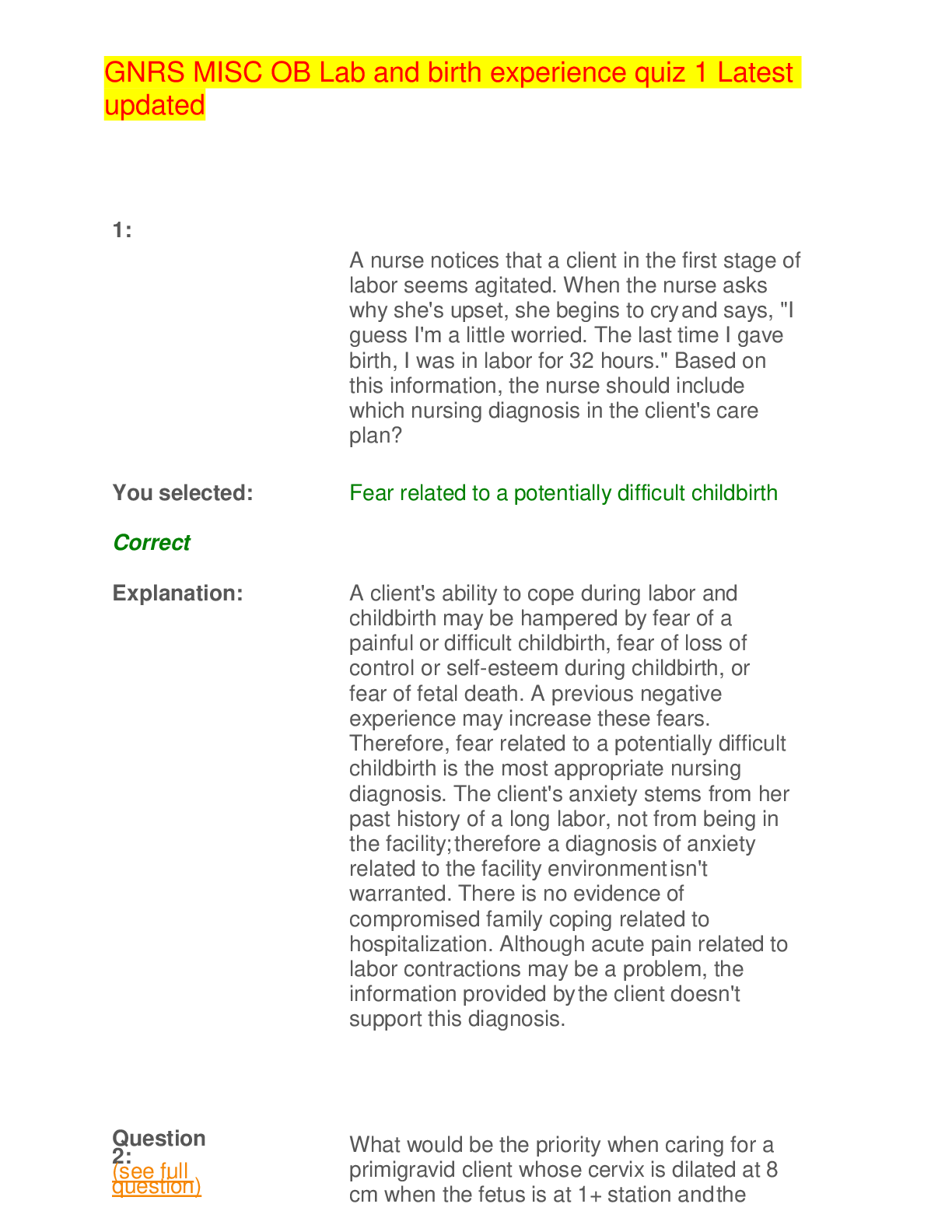
Reviews( 0 )
Document information
Connected school, study & course
About the document
Uploaded On
Sep 24, 2022
Number of pages
27
Written in
Additional information
This document has been written for:
Uploaded
Sep 24, 2022
Downloads
0
Views
32

















.png)









